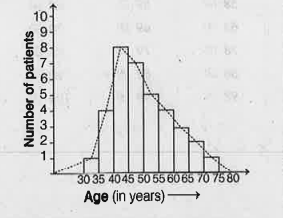In the year 2001, the number of malaria patients admitted in the hospitals of a state was 4,375. Every year this number decreases by 8%. Find the number of patients in 2003.
To find the number of malaria patients in 2003, we will follow these steps:
Step 1: Identify the initial number of patients and the rate of decrease.
- In 2001, the number of malaria patients was 4,375.
- The number of patients decreases by 8% each year.
Step 2: Determine the time period.
- We need to find the number of patients in 2003.
- The time period from 2001 to 2003 is 2 years.
Step 3: Use the formula for calculating the number of patients after a certain percentage decrease.
- The formula we will use is:
A=P×(1−R100)T
where:
- A = number of patients after T years
- P = initial number of patients (4,375)
- R = rate of decrease (8%)
- T = time period in years (2)
Step 4: Substitute the values into the formula.
- Substitute P=4375, R=8, and T=2:
A=4375×(1−8100)2
Step 5: Calculate the value inside the parentheses.
- Calculate 1−8100=1−0.08=0.92.
Step 6: Raise the result to the power of 2.
- Now calculate (0.92)2:
(0.92)2=0.8464
Step 7: Multiply by the initial number of patients.
- Now, substitute back into the equation:
A=4375×0.8464
Step 8: Perform the multiplication.
- Calculate 4375×0.8464:
A≈3703
Final Answer:
- Therefore, the number of malaria patients in 2003 is approximately 3,703.
---
- In 2001, the number of malaria patients was 4,375.
- The number of patients decreases by 8% each year.
- We need to find the number of patients in 2003.
- The time period from 2001 to 2003 is 2 years.
- The formula we will use is:
A=P×(1−R100)T
where:
- A = number of patients after T years
- P = initial number of patients (4,375)
- R = rate of decrease (8%)
- T = time period in years (2)
- Substitute P=4375, R=8, and T=2:
A=4375×(1−8100)2
- Calculate 1−8100=1−0.08=0.92.
- Now calculate (0.92)2:
(0.92)2=0.8464
- Now, substitute back into the equation:
A=4375×0.8464
- Calculate 4375×0.8464:
A≈3703
- Therefore, the number of malaria patients in 2003 is approximately 3,703.
Topper's Solved these Questions
- COMPARING QUANTITIESBOOK - NCERT EXEMPLARCHAPTER - COMPARING QUANTITIESEXERCISE - Appications, Gamess and Puzzles
1 Videos
- COMPARING QUANTITIESBOOK - NCERT EXEMPLARCHAPTER - COMPARING QUANTITIESEXERCISE - Think and Discuss
2 Videos
- COMPARING QUANTITIESBOOK - NCERT EXEMPLARCHAPTER - COMPARING QUANTITIESEXERCISE - Think and Discuss
2 Videos
- ALGEBRAIC EXPRESSIONS, IDENTITIES AND FACTORISATION BOOK - NCERT EXEMPLARCHAPTER - ALGEBRAIC EXPRESSIONS, IDENTITIES AND FACTORISATION EXERCISE - EXERCISE
328 Videos
- DATA HANDLINGBOOK - NCERT EXEMPLARCHAPTER - DATA HANDLINGEXERCISE - EXERCISE
73 Videos
Similar Questions
Direction: In the graph, number of patients admitted in a hospital as per age, in a day, is given. Study the graph carefully and answer the questions.

Find total number of patients between 55 yr to 60 yr, admitted in hospital in a day.
View SolutionDirection: In the graph, number of patients admitted in a hospital as per age, in a day, is given. Study the graph carefully and answer the questions.

Find total number of pateints
View Solution
Knowledge Check
A number decreased by 8% gives 69. the number is
A80B75C85Dnone of theseNumber of malaria patients every year is
A1000 millionB400 millionC100 millionD40 millionThe reason for the increasing number of malaria patients is that
Athe population has greatly increased rendering any effort to maintain cleanliness almost impossibleBthe mosquitoes have become DDT resistantCthe sanitary conditions are poor in villagesDall the above
There are 800 doctors and 3600 patients in a hospital. Find the ratio of the number of doctors to the number of patients.
View Solutionfind a number whose 8% is 6
View SolutionIf a number is decreased by 25% that number becomes 96. Find the number ?
View SolutionDeaths due to malaria every year number
View SolutionStudy the given graph and asnwer the question that follows.

The number of patients aged
The number of patients aged 10 or more years but below 40 years is what per cent less than the number of patients aged 50 or more years but below 80 years ?
View Solution
